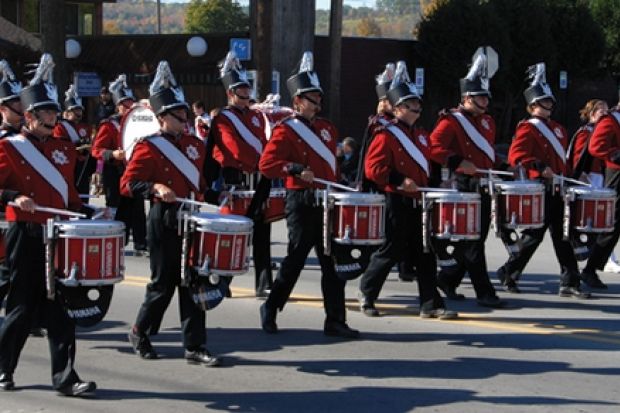Source: Mansfield University
Esprit de corps: the marching band of Mansfield University, one of the US institutions to have hired a senior ex-military figure
When Francis Hendricks took over this month as president of Mansfield University in Pennsylvania, academics and students may have felt the urge to salute.
Mr Hendricks is a former US Air Force brigadier general, one of a number of ex-military leaders being appointed to high-level positions at US universities as institutions cope with growing pressures to reform.
“The expertise we need now from a president in this transitional time for higher education isn’t managing the faculty,” said Ralph Meyer, chairman of the public university’s governing council of trustees.
“You have a provost who can handle all the academic issues. It’s the external issues - the fundraising, the community support, recruitment and retention of students, productivity.
“That’s a different skill set (from that of the) typical academician…”
Mr Hendricks is not the first such appointment. A former US Marine Corps commandant, Charles “Chuck” Krulak, took over in 2011 as president of Birmingham-Southern College, and the president of Georgia Gwinnett College is a former US Army brigadier general, Daniel Kaufman.
At Harrisburg University of Science and Technology, associate vice-president Dale Hamby is an Army veteran whose wife was a rear admiral in the US Navy. Meanwhile, Charles Rose, the head of a programme in trial advocacy at the law school of Stetson University in Florida, is a former army intelligence officer and judge advocate.
Universities “are looking for people who can manage complex operations with limited resources, and that’s what military leaders do,” Mr Kaufman said.
The military-educational complex
The military-higher education connection is not entirely new in the US. The US Military Academy at West Point was the nation’s first established engineering school, for instance, and many of the early presidents of civilian engineering universities tended to be West Point graduates or academics.
In 1948, former five-star general and future US president Dwight Eisenhower took up the presidency of Columbia University, although his involvement in many other activities and ties to conservative business interests caused a rift with academics at the university.
The transition is still far from seamless, thanks in large part to the differences between military discipline and academic governance.
“It is an adjustment,” Mr Kaufman said. “Although institutions look hierarchical on paper, they don’t operate that way. Frankly, you can’t just declare it to be done and just expect it to be done.”
He said he also had to learn to fundraise. “One thing military officers don’t do is beg for money,” he said. “That’s a skill you have to acquire somewhere along the way.”
Some of the universities where these military veterans work make their prior jobs the subject of good-natured fun. At Birmingham-Southern, students wear T-shirts that read “The General’s Got My Back”.
“Most military officers don’t sit behind a desk,” said Mr Krulak, who was known as “the General” in messages he posted online while serving as a non-executive director of Aston Villa when he lived in the UK.
“They’re very comfortable talking to young people because they’ve done it all their lives. They’re not trying to impress people. They’ve already been there and done that.”
He said he and his fellow former generals - accustomed as they are to large organisations with dense bureaucracies - can also cut through “all the wrappings that surround academia, whether it’s the shared governance or making sure that the academic programmes are right, to focus on the things that are most pressing”.
Mission positive
Back at Mansfield, “people are coming in and saying, ‘will we have to report in?’” joked Mr Hendricks. He said he is also getting used to deciding what to wear every day, since his move from the military to academia means that he is no longer in uniform.
But he added that what the two organisations have in common is that they are “service-oriented and focused on objectives that are for the greater good of society”.
“As a senior military leader, you [also] share with your respective college counterparts the seemingly timeless dilemma of doing more with less.”
Register to continue
Why register?
- Registration is free and only takes a moment
- Once registered, you can read 3 articles a month
- Sign up for our newsletter
Subscribe
Or subscribe for unlimited access to:
- Unlimited access to news, views, insights & reviews
- Digital editions
- Digital access to THE’s university and college rankings analysis
Already registered or a current subscriber? Login




